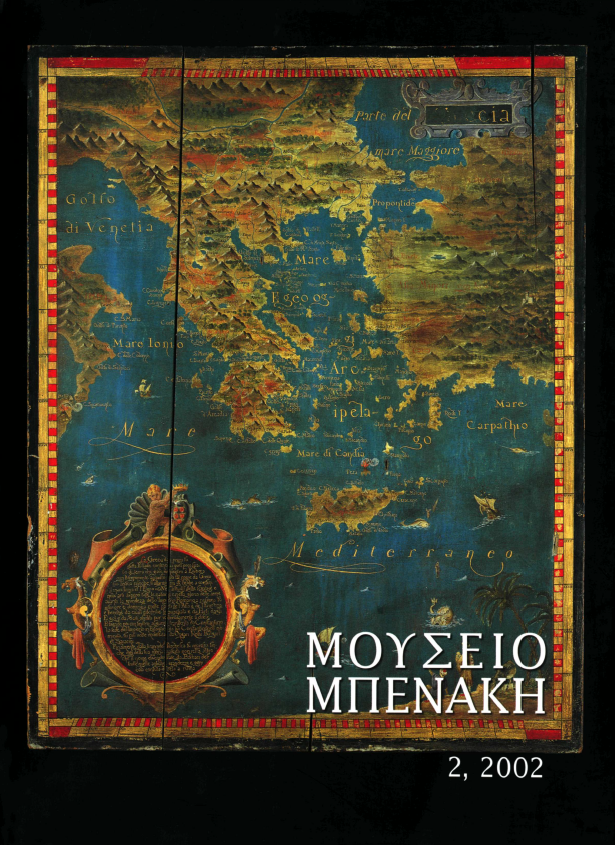The First Symphony of Yiannis A. Papaioannou
Abstract
The Yiannis Α. Papaioannou (Kavala 1910 – Athens 1989) archive is the most important musical archive in the Benaki Museum's Department of Historical Archives, which contains several archives and manuscripts of Greek composers. The composer's entire output, 224 individual works and collections of pieces, was presented to the Museum in 1990 by his widow, Irene Papaioannou, so that it should be readily accessible to musicians and scholars. The 118 files contain manuscripts of the composer's work and a rich supply of accompanying material. They are supplemented by a sound archive of recorded works and interviews with the composer, academic writings and the two editions of the catalogue of his work. Papaioannou's output, which includes every musical form except opera, was divided by the composer in-to six periods according to the techniques and me-thods he was following at the time. He started with impressionism and the use of elements drawn from traditional and Byzantine music, but after the first years of the 1950s he switched to more modern techniques such as dodecaphony, serialism and post-serialism, and after 1966 he adopted an entirely personal atonal musical syntax which he followed until the end of his life. Symphony No. 1 (1946) dates from his tonal period, before his decisive change to atonality and dodecaphony, at a time when the composer's main concern seems to have been the issue of borrowings from Greek traditional music, popular and Byzantine. This is one of the major questions which preoccupied the world of Greek classical music from the outset, and led to solutions which were to a greater or lesser degree loaded both stylistically and ideologically. In the First Symphony we do not find Kalomiris' idealization of borrowings from traditional music, but the composer's intention to make the work sound "Greek" is always in evidence. Yet a close analysis shows that his essential interest lies in the exploitation of modern structural elements (often derived from impressionism), of which he makes skilful use, without restricting himself by following "nationalist" musical trends. This insistence on a Greek 'aroma is not irrelevant to an understanding of the history of Greek classical music. It is of course associated with a predisposition towards the creation of a Greek identity, but it differs greatly from the practice of Kalomiris' circle, and does not proclaim the glory of the 'national schools'. After the collapse of the 'Great Idea', the entire intellectual world of Greece tried to reorientate itself to the new socio-political conditions. The démythification of the past became a priority, as well as the need to redefine 'Greekness' in every area of thought and expression. Against the background of this major historical and cultural crisis, the First Symphony shows Papaioannou identifying himself as an intellectual prepared to assume his responsibilities towards the issue as a whole, and not simply as a composer who seeks exotic or original sources of inspiration.
Article Details
- How to Cite
-
Κοκκώνης Γ. (2018). The First Symphony of Yiannis A. Papaioannou. Mouseio Benaki Journal, 2, 183–192. https://doi.org/10.12681/benaki.18198
- Issue
- Vol. 2 (2002)
- Section
- Articles

This work is licensed under a Creative Commons Attribution-NonCommercial-ShareAlike 4.0 International License.
The copyright for articles published in Mouseio Benaki is retained by the author(s), with first publication rights granted to the journal. By virtue of their appearance in this open access journal, articles may be used freely for non-commercial uses, with the exception of the non-granted right to make derivative works, with proper reference to the author(s) and its first publication. The Benaki Museum retains the right to publish, reproduce, publicly display, distribute, and use articles published in Mouseio Benaki in any and all formats and media, either separately or as part of collective works, worldwide and for the full term of copyright. This includes, but is not limited to, the right to publish articles in an issue of Mouseio Benaki, copy and distribute individual reprints of the articles, authorize reproduction of articles in their entirety in another publication of the Benaki Museum, as well as authorize reproduction and distribution of articles or abstracts thereof by means of computerized retrieval systems.


